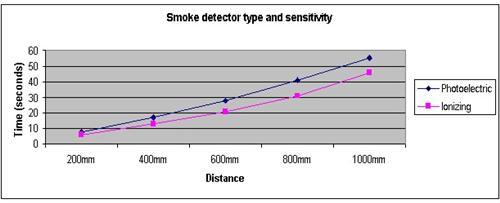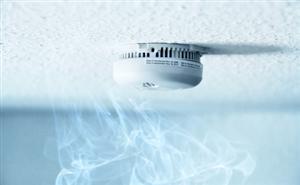| Complexity level: | 6 |
| Project cost ($): | 30 |
| Time required: | 1 hour for preparation, 2 hours for observation |
| Material availability: | Easily found at a hobby store |
| Safety concerns: | Adult supervision required. Take all necessary precautions to ensure fire safety. Be extremely careful when handling fire. |
Hypothesis
The ionizing smoke detector will be able to detect smoke more quickly.
Overview
Smoke detectors
Smoke detectors are devices that are used to help in detecting smoke and preventing fires. They are installed in commercial buildings, factories, hotels and homes. These devices will normally be connected to an alarm system which will be triggered when smoke or fire is detected. Most smoke detectors will operate using photoelectric sensing or by ionizing detection. Some smoke detectors will use both for increased sensitivity.
A photoelectric smoke detector uses optical detection. It has an LED light source and a light sensor. Under normal conditions, the light from the LED will travel in front of the light sensor in a straight line. However, when smoke is present, the light from the LED will be scattered, and this will be detected by the light sensor, triggering the alarm.
Ionizing smoke detectors are able to detect smoke particles that are very small and cannot be seen by the naked eye. It has Americium-241 radioactive isotopes and 2 electrodes. Under normal conditions, the radiation will permit a small current to pass in between the electrodes. However, when smoke is present between the electrodes, the ionization is reduced and the fire alarm triggered. Although ionizing smoke detectors are cheaper than photoelectric smoke detectors, they are more prone to nuisance triggers.
Scientific Terms
Materials
The materials required for this science fair project:
- A photoelectric smoke detector
- A ionizing smoke detector
- 2 alarms
- A pack of cigarettes
- A lighter
- An ashtray
- A long ruler
- A stopwatch
Procedure
1. For this science fair project, the independent variable is the type of smoke detector used (photoelectric or ionizing) and the distance of the smoke detector from the source of the smoke. The dependent variable is the time taken for the smoke detector to trigger the alarm. This is determined by checking the time using a stopwatch. The constants (control variables) are the source of the smoke, the sensitivity of the smoke detectors and the temperature of the environment, which will remain at room temperature.
2. Purchase a photoelectric smoke detector, an ionizing smoke detector and 2 alarms. Connect the alarm to the smoke detectors and test them before starting the experiment.
3. Light a cigarette and place it on the ashtray. Hold the photoelectric smoke detector 200mm above the cigarette. Start the stopwatch and observe the time taken for the alarm to be triggered. Record the time taken to trigger the alarm in a table, as shown below.
4. Repeat step 3, holding the ionizing smoke detector at a height of 200mm, and record the time taken for the alarm to trigger in a table, as shown below.
5. Repeat steps 3 and 4 by holding the smoke detectors at 400mm, 600mm, 800mm and 1000mm above the cigarette. Record the time measured in a table, as shown below.

Results
It was observed that the ionizing smoke detector is more sensitive and able to detect the cigarette smoke faster than the photoelectric smoke detector.
| Smoke detector type | Time to detect cigarette smoke at various distances (seconds) | ||||
| 200mm | 200mm | 400mm | 600mm | 800mm | 1000mm |
| Photoelectric | 8 | 17 | 28 | 41 | 55 |
| Ionizing | 6 | 13 | 21 | 31 | 46 |
The above results were then plotted onto a graph, as shown below.

Conclusion
The hypothesis that the ionizing smoke detector would be able to detect the smoke more effectively, has been proven to be true.
Smoke detectors are very important devices that function as an early warning system when a fire is detected. They enable us to take the necessary measures to stop the fire before it spreads and becomes more difficult to manage. Smoke detectors can help to save lives and reduce the damage caused by sudden fires in homes, as well as commercial and industrial buildings.
Also consider
Try to repeat this science fair project by using other sources of smoke like a candle, joss stick or burning papers.
The experiment can also be repeated by placing the smoke detector in different positions around the smoke detector.
References
Smoke detectors - http://en.wikipedia.org/wiki/Smoke_detector
How smoke detectors work - http://chemistry.about.com/cs/howthingswork/a/aa071401a.htm

